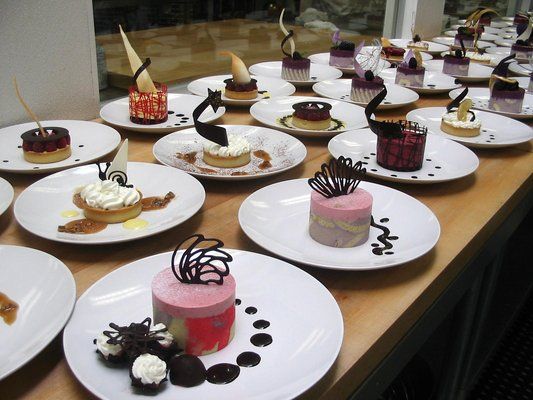Baking is itself an art and plating makes it more than an art Art is refered as an expression of creativity and as baker, we create with our minds and our hearts. As with any form of art, it is subjective.It is entirely up to the guest to decide if it’s good or bad, however, dessert can’t just be appealing to the taste, it needs to eye-catching too.
“Plating” refers to the art of arranging, decorating, and presenting food in a way that improves its aesthetic appeal to the diner when served.To create a balanced plate and a memorable experience the pastry chef should consider the following key elements.
Flavor
You can create the most elaborate dessert, but without flavor, the design will be forgotten. The flavor of the main component should be the dominant flavor on the plate. The plate should be composed of no more than three flavors. Once the main flavor is selected, choose two other flavors that will complement it. The flavor is the single most important element on the plate.
Texture
Utilising contrasting components in a dessert creates an interesting experience. Try to work soft, crunchy, fatty, dry, and smooth textures into your desserts to keep your guest interested. Eating the same texture can become boring.
Color
The main challenge is understanding when there is enough color on a plate, and not adding color just for the sake of adding color. A vibrant colorful plate can look very attractive but not all desserts need a variety of colors: monochromatic plates can be just as attractive and taste equally as good.
Shape
Shapes are to the eye what flavors are to the palate. The plate can have complementary and contrasting shapes to create interest and flow on the plate. A swoosh of sauce or an elegant garnish will catch the eye and bring it to the main component.
Creating a great dessert is not an easy task but it is a fun one. I always try to remember that sometimes less is more, adding too much might cause things to seem busy or confusing. It’s easy to get caught up in all the many garnishes used on plated desserts, yet remember without flavor the dessert will not be successful.
weighing and measuring, creaming, piping, lining (moulds), addition of colour or flavour, folding, moulding, mixing, aeration, slicing, portioning, chilling, combining.
Garnish – made from fruits, chocolate lines and powdered sugar. Usually a final component of a plated dessert.
Base: typically crispy or cake-like
Filling: creamy element or ripe fruit
Sauce: complementary to enhance the colors, textures and flavors of the other components
Textural component: such as a crispy cookie or dried fruit chip
Garnishes: edible and functional
The main item is usually the focal point of the plate. On a savory dish, this is often a protein such as meat, fish, or poultry that requires butchering skills, portion control, and cooking techniques of the highest caliber, to achieve the desired results that are essential to the success of the plate presentation.
But most will still agree that the most important factor in creating an exceptional plated dessert is flavour. Whether it is a simple slice of pie served in a casual restaurant, or an intricate, multicomponent dessert crafted for a fine dining establishment, flavour is what makes a dessert memorable.






